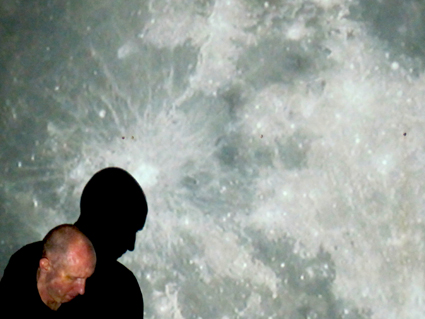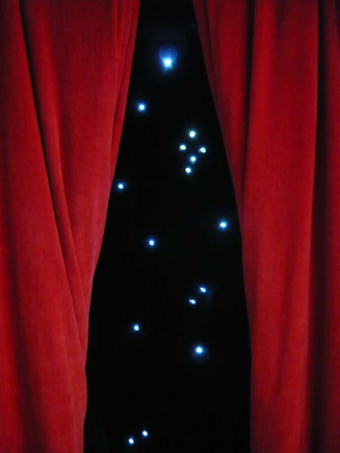 |
mumble(speak) live at FELTspace, Adelaide (2010) courtesy FELTspace ARI, Adelaide. |
III - real and imagined scenarios offers 11 haunting meditations that are rich and multi-layered while maintaining a sense of ever expanding space; the depthless chasm of the unconscious perhaps. There is a timelessness to these pieces with little sense of urgent progression, yet they never succumb to stasis. The palette of sounds across the album melds recognisable midi and acoustic instruments with field recording and otherworldly sounds from unidentifiable sources. This is the first time Warren has used instrumental and sample contributions from other artists—Laura Altman, Carolyn Gannell, Felix Ratcliff, Mark Spybey and Sara Pensalfini—which he has interwoven subtly and effectively, particularly on the track “Loud as Ghosts.” “Entropic Flush” and “Departure” feature arpeggiated guitar which lends the album a folktronic flavour. Spoken text occasionally appears, sometimes as texture, sometimes as fragments of narrative and is generally well pitched and evocative with the exception of “silence” uttered at the end of “Entropic Flush,” which feels overstated. But as a whole, real and imagined scenarios presents a wonderfully dark and complex sonic world, offering equal parts pleasure and perturbation.
Gothic landscapes
The sonic other/underworld described by III - real and imagined scenarios could be seen to be indicative of Tasmania’s particular brand of gothic. I asked Warren (via email) to what extent he feels his work is influenced by the place where he resides.
“The gothic sense to Tasmania is not something I always notice; I mean living here you may just take much of it for granted and it's probably harder to be objective about it than it would be for a 'mainlander.' But there would have to be something unconscious [here]. There is a dark beauty definitely, some pretty harsh landscapes, some bleak history. Much of my work deals with transcendental states, creating aural and visual environments that sit liminally between faith and rationality. The hauntological element is quite personal in a way, insomuch as it deals with my own history, but it's a shared history, cultural mainly and likely generational. I utilise those elements, sound, music, images and so on in an abstracted way that allows others to get an empathetic sense of it without it being blatant [or] overtly personal. It becomes a kind of dreamscape. Perhaps Tasmania contributes to that.”
 |
The Lull, light and sound installation detail (2010) photo Matt Warren |
Dream mediums
Warren began his artistic life as a painter and moved into sound and music. He describes his interest in sound as a medium: “I think I enjoy how it abstractly hits you, emotionally, cerebrally; how it can alter or enhance your mood and how it exists in the world—how it's great in a gallery or a performance space, but does not need that framework to reach someone. I'm [passionate about] music in particular and sound in general.”
Warren also works frequently with video (most recently on the installation The Snowman with Sally Rees—see Partnering Art) and I asked him how he sees sound and moving image relating in his practice. “I think the projects define their own mediums. The relation between video and sound is often quite cinematic, insomuch as, regardless of how abstract the video is, the sound should have some kind of logic [in relation] to the image. In my formative years of art making, I often felt the sound kind of 'finished off' the video, but I don't feel that way as much today and just as often I consider video will work just as well silent. Interestingly, I've been thinking that I would like to create sound works that could be accompanied by still images, photographs in a space or in a book. But often sound can be so immersive that it can create visual imaginings in the listener. Performance is another element insomuch as the nature of a physical being in the room brings with it a whole other presence and interactivity with the sound.”
Gathering dust and silence
In the last few years Matt Warren has also turned his ear and eye to curation. His motivation he admits is “as simple as wanting to see or experience something I haven't yet seen.” In 2012 he undertook an emerging curatorial mentorship at Contemporary Art Tasmania (formerly CAST) resulting in the exhibition In A Silent Way that involved eight sound artists with all the sound works playing in the gallery simultaneously. Warren says he was thinking “about the issues of group media shows, how works can co-exist and still have their own space. I was also thinking about how noisy the world is and, as a kind of antidote to that, invited artists to make or contribute works designed to be played quietly, co-existing, quietly merging with each other and with the sound of the outside world.”
Last year Warren curated Ghost Hunters at the Plimsoll Galleries which at the time had been defunded and was not being used. He says, “I thought about [the] artists as kind of paranormal investigators, basically using sound and video of the empty, silent space to create works, trying to reveal something about the space, the residue of all that had come before.” The curatorial premise built on a methodology that Warren employed in his own work for his PhD that involved recording empty buildings, the duration dependent on the age of the building, then boosting the recordings by 200% to hear the sonic residue of the past.
Isolation and objectivity
While Warren has undertaken a number of travel fellowships over the years, including an Anne & Gordon Samstag Fellowship to do a Masters degree in Vancouver in 1999, he has never felt the need to leave Tasmania permanently to develop his practice. “I feel the local sound and contemporary art scenes are quite lively and have a sense of rigour. They are often nicely intermingled and probably due to the size [of the scene] are quite supportive of each other. And as far as I can tell, it's always been that way. Obviously Tasmania has had a greater national and international art/music focus of late, but there has been a small but vibrant scene here for a long time. In the scheme of things, perhaps staying here has affected my career trajectory. Of course lots of show offers or exhibitions would always be nice, however I'm happy to follow my own path. I once wanted to move to a bigger city to live and work, but [now] I feel that cons would probably outweigh the pros. I don't feel isolated here and there’s a nice degree of objectivity about the rest of the art/sound world that can come with just being a little removed from it.”
mumble(speak), III - real and imagined scenarios; http://mumblespeak.bandcamp.com/; http://roomofsilencerecords.bandcamp.com/; http://www.mattwarren.com.au
See also Matt Warren & Sally Rees in Partner Art and our review of Motel Dreaming by the Unconscious Collective of which Matt Warren is part.
RealTime issue #122 Aug-Sept 2014 pg. web
© Gail Priest; for permission to reproduce apply to [email protected]








 back
back